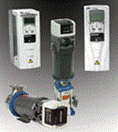VFD’s For Pumps
Variable Frequency Drives
Application: Water / Wastewater Pumping
Reading Electric, a leading supplier of electro-mechanical equipment, services, and problem solver for Industrial and Commercial customers for over 50 years provides technical information to the Region’s Residential, Commercial and Industrial Community. This Bulletin provides information on application of Variable Frequency Drives for Pumping of Water and Wastewater.
Variable Frequency Drive
A variable-frequency drive is an electronic controller that provides continuous control matching motor speed to the specific demands of the work being performed.
Used In Water / Wastewater Treatment Process
 Variable-frequency drives are enjoying rapidly increasing popularity at water and waste-water facilities, where the greatest energy draw comes from pumping and aeration—two applications particularly suited to variable-frequency drives. For applications where flow requirements vary, mechanical devices such as flow-restricting valves or moveable air vanes are often used to control flow, which is akin to driving a car at full throttle while using the brake to control speed. This process uses excessive energy and may create punishing conditions for the mechanical equipment involved. Variable-frequency drives enable pumps to accommodate fluctuating demand, running pumps at lower speeds and drawing less energy while still meeting pumping needs. Figure 1 illustrates the reduced energy consumption of variable-frequency drives over valve control systems. Variable-frequency drives work with most three-phase electric motors, so existing pumps and blowers that use throttling devices can be retrofit with these controls.
Variable-frequency drives are enjoying rapidly increasing popularity at water and waste-water facilities, where the greatest energy draw comes from pumping and aeration—two applications particularly suited to variable-frequency drives. For applications where flow requirements vary, mechanical devices such as flow-restricting valves or moveable air vanes are often used to control flow, which is akin to driving a car at full throttle while using the brake to control speed. This process uses excessive energy and may create punishing conditions for the mechanical equipment involved. Variable-frequency drives enable pumps to accommodate fluctuating demand, running pumps at lower speeds and drawing less energy while still meeting pumping needs. Figure 1 illustrates the reduced energy consumption of variable-frequency drives over valve control systems. Variable-frequency drives work with most three-phase electric motors, so existing pumps and blowers that use throttling devices can be retrofit with these controls.
Benefits
 Across the line motor starters subjected to high motor torque, the current surges up to 10 times the full-load current. In contrast, variable-frequency drives offer a “soft start” capability, gradually ramping up a motor to operating speed. This lessens mechanical and electrical stress on the motor system and can reduce maintenance and repair costs and extend motor life.
Across the line motor starters subjected to high motor torque, the current surges up to 10 times the full-load current. In contrast, variable-frequency drives offer a “soft start” capability, gradually ramping up a motor to operating speed. This lessens mechanical and electrical stress on the motor system and can reduce maintenance and repair costs and extend motor life.
 With the help of ‘User Friendly Interfaces’ variable-frequency drives allow more precise control of processes such as water distribution, aeration and chemical feed. Wastewater treatment plants can consistently maintain desired dissolved oxygen concentrations over a wide range of flow and biological loading conditions by using automated controls to link dissolved oxygen sensors to variable-frequency drives on the aeration blowers.
With the help of ‘User Friendly Interfaces’ variable-frequency drives allow more precise control of processes such as water distribution, aeration and chemical feed. Wastewater treatment plants can consistently maintain desired dissolved oxygen concentrations over a wide range of flow and biological loading conditions by using automated controls to link dissolved oxygen sensors to variable-frequency drives on the aeration blowers.
Energy savings from variable-frequency drives can be significant. Affinity laws for centrifugal pumps suggest that even a small reduction in motor speed will highly leverage your energy savings. Variable-frequency drives can reduce a pump’s energy use by as much as 50%. Because this benefit varies depending on system variables such as pump size, load profile, amount of static head, and friction, it is important to calculate benefits for each application before specifying a variable-frequency drive.
Remember: We offer 24 / 7 Repair Service.
For more information on Variable Frequency Drives, Contact Rich Polityka @ Reading Electric.

Recent Comments